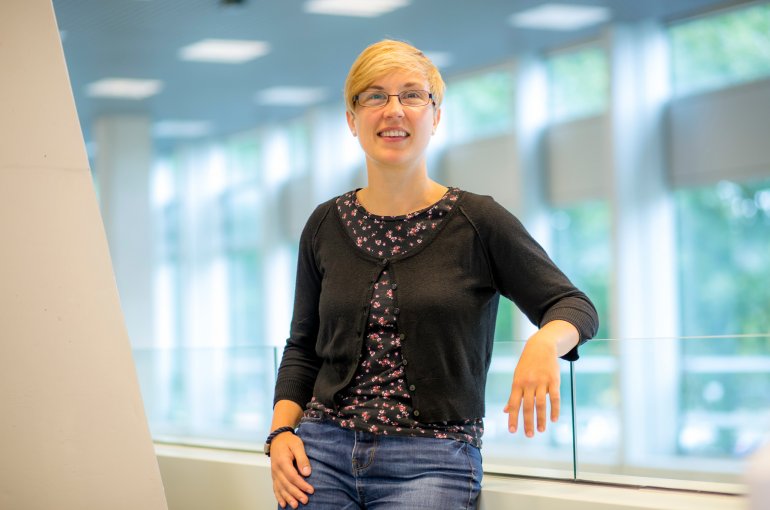“Where do all these women have to come from?”
Interview with Westerdijk Fellow Dr. Anna-Lena Lamprecht

"Utrecht isn’t just saying that they welcome researchers and students with different backgrounds. They seem ready for it and doing it."
As a teenager growing up in Germany, Anna-Lena Lamprecht was interested in studying either history or computer science. She chose the latter, and so far she has never regretted it. Today, Dr. Lamprecht works as an Assistant Professor in the Software Technology group at the Faculty of Science’s Department of Information and Computing Sciences. Her appointment was accompanied by a Westerdijk Fellowship, a tenure-track programme established to attract outstanding female talent and stimulate gender diversity within the faculty. “Some people around me would ask me why I applied for a ‘pink position’,” says Anna-Lena, “but calling it that feels like an oversimplified opinion to me.”
An interview about her own view on the topic of gender diversity in academia.
After studying in Göttingen, taking a PhD position in Dortmund, a postdoc in Potsdam and a research position at the Irish software research centre Lero, Anna-Lena Lamprecht decided that accepting the Westerdijk position in Utrecht should be her next step. “The fact that I took a position that was especially aimed at women doesn’t mean I couldn’t compete with the men in my field,” says Anna-Lena, “because at the same time, I had two job offers from other universities as well.”
Just as hard
Anna-Lena decided in favour of the computer science department in Utrecht because they were looking for someone to broaden their range of research with an interdisciplinary focus, which she found very appealing. In addition to teaching Modelling and Systems Design to 300 Bachelor’s students and developing a new course in computational thinking for the Master’s programme, Anna-Lena now conducts research on software development for scientific needs.
She never felt being a woman made it easier for her to get the position in Utrecht. “The competition for the Westerdijk Fellowship was just as hard as anywhere else.“
Nevertheless, the Westerdijk Fellowship is a direct result of Utrecht University’s strategic decision to attract more female researchers. Anna-Lena doesn’t think this means that the university would appoint any women, just to meet the wish of gender diversity. “You have to approach it the other way around,” she says. “It isn’t about quota that need to be fulfilled, but more about the question: how can universities attract the best researchers, amongst whom are also more women? In other words: how can we motivate the best of these few female researchers in male-dominated fields to apply here in Utrecht?”
Male-female ratio
Anna-Lena elaborates upon this by illustrating that, in the field of computer science, it is common that out of 80 applications, only four or five are from women. But that it doesn’t necessarily mean that those five female applicants are the best ones for the job.
“I’ve been part of committees with mostly men in them, and I have noticed that sometimes they would invite a woman just to give a female researcher the chance to get interviewed as well. But in some cases, it was clear to me that she wasn’t the best candidate for the job in the first place. So why invite her anyhow? It’s unfair to let her do the job interview, which costs a lot of effort and energy, when deep down inside you already know that it isn’t the best fit.”
Ambivalent issue
According to Anna-Lena, the issue of gender diversity is therefore sometimes an ambivalent one. She asks herself if it is realistic to want to have committees that consist of 50 percent women and 50 percent men, for example.
“If only 10 to 20 percent of your employees are female, like in the Computer Science department, where do all those women have to come from? The same applies to the wish of having more women in higher positions. Only 10 to 20 percent of first-year students are female, so how can you expect that the percentages rise in higher positions, if women aren’t there in the first place? You have to start balancing the male-female ratio at a much earlier level in the school system and not wait until people have entered academia.”
Choice of words
Anna-Lena recently attended a departmental workshop on ‘Gender Inclusion and Diversity Awareness’. The topic sparked a lot of discussion, which she found very interesting. “In this workshop it was stated that the male-female ratio among job applicants is unconsciously influenced by the choice of words in job advertisements. For example, it seems that terms like ‘challenge’ and ‘leader’ are more associated with masculine qualities, having the effect that fewer female applicants feel addressed by the job description.”
Studies have indeed shown that if equivalents of those words (like for example ‘motivate’ and ‘role model’) are used, more females would apply. “At the same time, studies have shown that a higher proportion of females in selection committees does not have an effect on the male-female ratio in appointments,” says Anna-Lena. “But the women who do apply might feel more welcome when they face a mixed group at the job interview.”
Ready for it
Throughout her working history, Anna-Lena has been aware of diversity issues. At Lero, for example, she was part of a group that ran outreach events particularly targeted at secondary school girls aged 14 and up, to foster their interest in computer science.
“It’s nice to see that Utrecht University also pays attention to diversity in a lot of ways. Take the international focus, for example. In Germany, I’ve seen situations in which international PhD candidates really struggled with the fact that German is still the core language regarding paperwork. Here in Utrecht, working contracts are available in English. This makes me feel really welcome here. Utrecht isn’t just saying that they welcome researchers and students with different backgrounds. They seem ready for it and doing it. And that is absolutely great.”

